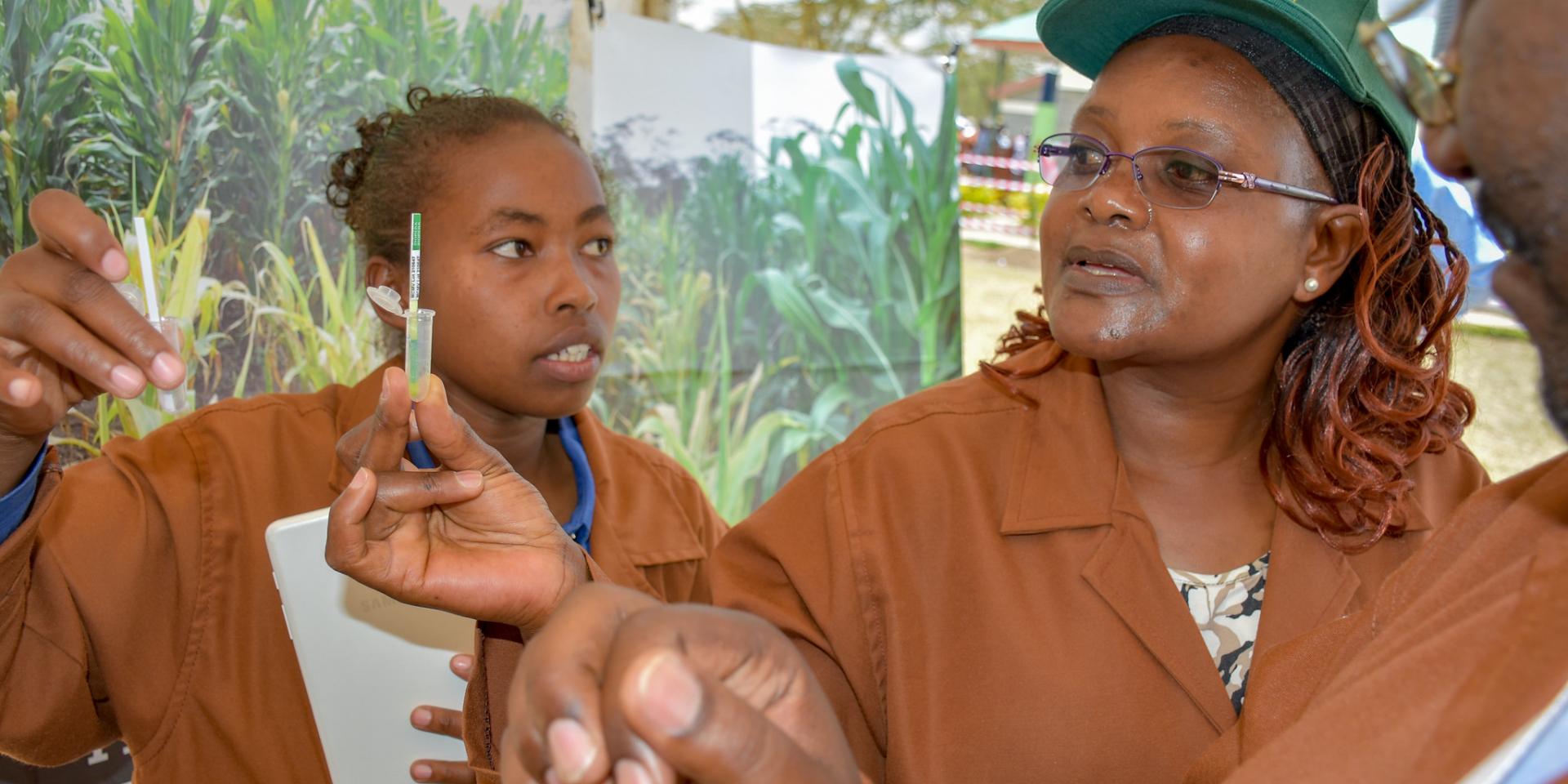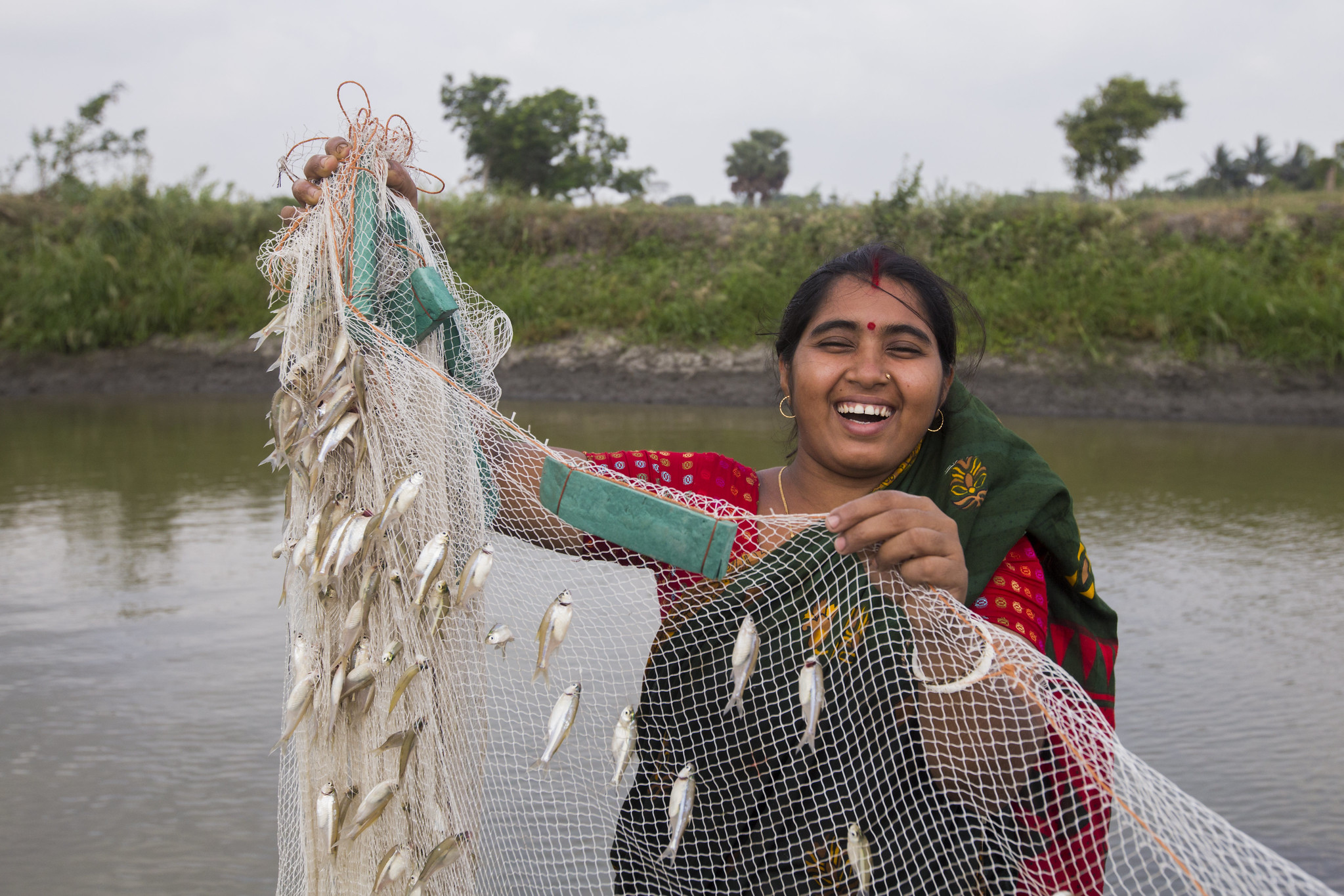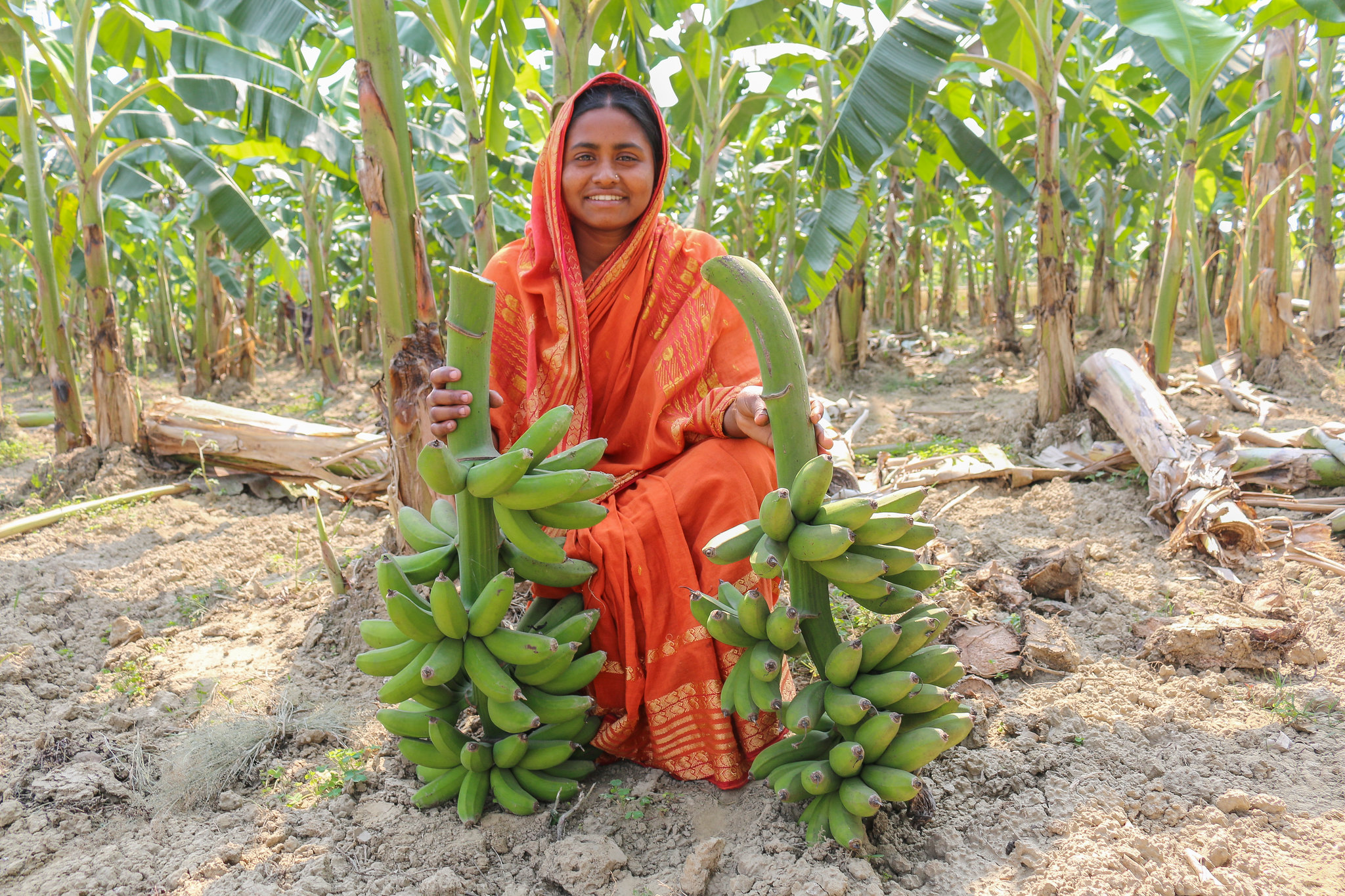Gender research tools help design CGIAR projects for nutrition outcomes
 Photo: Joshua Masinde/CIMMYT
Photo: Joshua Masinde/CIMMYT
Three CGIAR GENDER projects initiated in June last year are already proving their worth for researchers applying the Women’s Empowerment in Agriculture Index (WEAI) and nutrition tools.
WEAI provides well-known tools for measuring shifts in women’s and men’s empowerment. Less well known is WEAI’s ability to provide rich insights into people’s gender-relevant perceptions, beliefs and behaviors.
Three projects have been chosen to receive USD100,000, and they focus on vegetable seed systems among ethnic minorities in Vietnam, income-generation activities through orange-flesh sweet potatoes and other nutritious foods in Ghana, and small-scale fisheries and aquaculture in Bangladesh. The aim of these projects is to integrate gender more effectively into how we design, implement, monitor and evaluate nutrition-sensitive projects.
We asked the leaders of the three projects four questions about their use of WEAI and nutrition tools related to how they perceived the value of these tools, what they learnt, the challenges they faced and the advice they would give to other research teams.

A woman with fish caught using gill net in Bangladesh (Photo: WorldFish/Md. Masudur Rahaman)
The three projects
Alliance of Bioversity International and CIAT: “Women’s Empowerment in a Seed System for Nutrition Intervention Among Ethnic Minority Communities in Northern Vietnam” (led by Dr Deborah Nabuuma and Dr Kees Swaans)
International Potato Center (CIP): “Adaptation and Integration of Women’s Empowerment in Agriculture Index (WEAI) and Nutrition Assessment Approaches and Tools into the Context of Northern Ghana (AIWNA)” (led by Dr Jan W. Low and Dr Nozomi Kawarazuka)
WorldFish: “Women’s Empowerment and Improved Nutrition: An Assessment of a Project in Bangladesh Using an Adapted Version of Pro-WEAI for Small-scale Fisheries and Aquaculture (Pro-WEFI)” (led by Dr Surendran Rajaratnam and Dr Rahma Adam).
Understanding gender dynamics fills research gaps and helps measure impacts
Q. Tell us about the study where you applied WEAI and nutrition tools. Why did you think the use of these tools would add value to your project?
A. Vietnam, Dr Deborah Nabuuma and Dr Kees Swaans
“A seeds system project was being implemented in northern Vietnam to explore how increased access and use of high-quality seed could enhance smallholder nutrition and income security. Part of our project involved a Randomized Controlled Trial (RCT) in 36 villages and three minority ethnic groups—the H’mong, Thai and Dao—to study impact pathways from seeds to nutrition with a control group and two treatments. One group was given nutrition, seed and production training, and the other group was provided with diverse vegetable seeds. While the RCT had been designed to reach and benefit women, no gender specific tools and indicators had been planned or were in use aside from gender disaggregated data. The use of the pro-WEAI methodology therefore filled this important gap.”
B. Ghana, Dr Jan W. Low and Dr Nozomi Kawarazuka
“We used the pro-WEAI qualitative tools during the formative research stage of a new gender-transformative integrated agriculture-nutrition-marketing project (GROWING) in northern Ghana that began in March 2022. The community qualitative assessment guidelines gave us an excellent overview of the differences, both agroecological, socioeconomic and cultural, in the different districts. The qualitative approaches helped us to understand how local communities felt about the existing power structures, and in the case of women, how they consider what being empowered would mean to them. This resulted in us emphasizing attaining gender equity, rather than equality, when we designed our interventions. This is the first time CIP used the pro-WEAI tool, and improving women’s empowerment is our major goal in this project so having a validated indicator to use is a plus!”
C. Bangladesh, Dr Surendran Rajaratnam and Dr Rahma Adam
“We developed the Women’s Empowerment in Fisheries and Aquaculture Index (WEFI) by adapting the WEAI for aquaculture and fisheries contexts. We also drew lessons from the earlier versions of the index implemented in Zambia and Bangladesh. We then conducted cognitive testing of WEFI and further validated it in Bangladesh. We created a standardized version for project use called project-level WEFI (Pro-WEFI). We implemented the Pro-WEFI together with the pro-WEAI Health and Nutrition module in north western Bangladesh as part of the IDEA (Aquaculture: Increasing income, Diversifying diets, and Empowering) project. The IDEA project aims to empower up to two million women and increase women’s and children’s consumption of fish. The tool provided reliable data to measure progress towards these outcomes.”
Informing the development of future interventions by using WEAI-based tools
Q. How did the use of WEAI and nutrition tools help fill important knowledge gaps in your research project?
A. Vietnam, Dr Deborah Nabuuma and Dr Kees Swaans
“We were able to look at the gender dynamics within three ethnic groups in two districts in northern Vietnam by using the pro-WEAI tools. The tools provided an opportunity to measure empowerment and whether the project contributed to empowerment or disempowerment. The pro-WEAI results will provide valuable information when discussing project results and developing recommendations for future projects on seeds system for nutrition.”
B. Ghana, Dr Jan W. Low and Dr Nozomi Kawarazuka
“The qualitative information provided insights on the agroecological setting of the community and men and women’s roles in different crop production systems and off-farm labor. For example, one important revelation was the extent to which young women, not just young men, migrate south to seek work once the agriculture season is over. This will have implications for our intervention, which is based on having several interactive and training sessions. We are designing nutrition training and gender dialogue modules based on our new understanding of food sharing and purchasing practices.”
C. Bangladesh, Dr Surendran Rajaratnam and Dr Rahma Adam
“When we used the pro-WEAI health and nutrition module, more women reported being able to decide on their own and their child’s health and diet, but nearly one-third of the sampled women reported not having access to food and health products. This information is useful for the project and other agencies implementing their interventions in the communities to focus on women’s access to food and health products.”

A banana farmer in Bangladesh, who started cultivating the crop to diversify her diet and income (Photo: S.Quinn/CIP)
Training and building the capacity of researchers, data collectors and facilitators to use the tools
Q. Were there any challenges you encountered in applying the WEAI and nutrition tools? How did you overcome these challenges?
A. Vietnam, Dr Deborah Nabuuma and Dr Kees Swaans
“The team leading the field implementation had mixed experience with qualitative data, gender and WEAI tools, and the pandemic limited in-depth engagement. To address this, a capacity building workshop and regular meetings were held for the team to develop the protocol and prepare for data collection with support from gender experts. As extensive trainings and pre-tests were conducted in each district, translation challenges that emerged were addressed in the regular meetings.”
B. Ghana, Dr Jan W. Low and Dr Nozomi Kawarazuka
“To reach all the different ethnic communities, master’s students in University of Development Studies collected field data. Although all students received the same training, there were quality differences in the information collected between students. The WEAI team offered excellent training and guidance for us and were open to setting up special sessions to answer queries and assist in the evaluation design for the GROWING project.
Researchers working in multidisciplinary research settings often find it challenging to understand how other disciplines view and analyze gender. By applying a mixed methods approach using the WEAI tools, the research team can learn to speak a common language and better understand how both qualitative and quantitative results can be used meaningfully.”
C. Bangladesh, Dr Surendran Rajaratnam and Dr Rahma Adam
“First, it took approximately one and a half hours for the tool to be administered to respondents. To maximize the time spent with the respondents, we ensured that the identification of households and fixing of appointments with them were done before the actual study. It was very useful to do so as the respondents understood the reason for the study and the men especially made themselves available as they would typically be away from their houses for work.
Second, we found implementing the Pro-WEFI tool using CAPI software to be helpful by automating the process and by enabling real-time data checks to reduce errors.
Third, we found respondents, especially the men, found it difficult to comprehend the questions and provide answers in some of the modules. For example, questions on time were found challenging for both women and men because most of them multi-task. It required the enumerators to get the respondents to only provide answers to the primary activities conducted.”

Ly Thi Nguyen, market vendor (Photo: C. de Bode/CGIAR)
Applying tools early, allocating enough time and resources, and integrating with other perspectives
Q. What advice would you give to other research teams who would like to apply WEAI and nutrition tools in the field?
A. Vietnam, Dr Deborah Nabuuma
“Apply the methodology at the start of a study and ensure that the research team is gender aware. The qualitative tool at baseline helps the team to understand the empowerment context and issues. It provides a basis for designing more gender-sensitive and contextually adapted interventions. The research team must also make sure sufficient time and resources are allocated for these tasks. Additionally, data collectors should be closely guided by a gender expert and supervisors who comprehensively understand the tools.”
B. Ghana, Dr Jan W. Low and Dr Nozomi Kawarazuka
“The pro-WEIA quantitative tool is quite comprehensive and data entry programs already exist to assist in implementation, but it does require sufficient time and resources to implement well. That needs to be taken into account when planning the budget for training the enumeration staff and actually collecting the data.”
C. Bangladesh, Dr Surendran Rajaratnam and Dr Rahma Adam
“It is very important to get the research team members to be trained well and provide them with sufficient time to administer the tool. Households and respondents need to be clearly informed of the purpose of the study. We would also advise data collectors to take short breaks during the survey as respondents may lose interest and provide repetitive answers. It is advisable to have non-research related conversations during the short breaks to keep the respondents interested in the study.”


